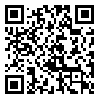BibTeX | RIS | EndNote | Medlars | ProCite | Reference Manager | RefWorks
Send citation to:
URL: http://jdm.tums.ac.ir/article-1-3-en.html
Background and Aims: The purpose of this in vitro study was to assess the effect of two different surface treatments on the contrast ratio of IPS e.max press ceramic submitted to accelerated aging.
Materials and Methods: Ten ceramic (IPS e.max Press) disks (10-mm diameter and 1.5-mm thick) were fabricated according to the manufacturer's recommendations. The samples were randomly divided into 2 groups (n=5): polishing and glazing. Contrast ratio ware obtained with a spectrophotometer before and after accelerated aging. The contrast ratio (CR=Yb/Yw), was defined as the ratio of illuminance (Y) of the test material when it is placed on the black background (Yb) to the illuminance of the same material when it is placed over a white background (Yw), was determined. The data were statistically analyzed by two-way analysis of variance (P<0.05).
Results: All specimens of IPS e.max press ceramic showed significant increase in CR after 300-hour accelerated aging time (P=0.005). Polished samples showed significantly higher opacity compared with that of the glazed ones (P=0.018).
Conclusion: Within the limitations of this study, it may be concluded that the glazed specimens showed higher stability in their translucency than the polished specimens.
Received: 2012/08/21 | Accepted: 2013/04/30 | Published: 2013/09/15
| Rights and Permissions | |
 |
This work is licensed under a Creative Commons Attribution-NonCommercial 4.0 International License. |




